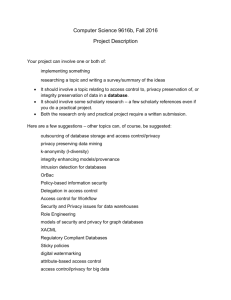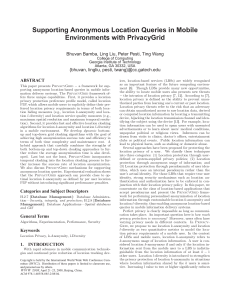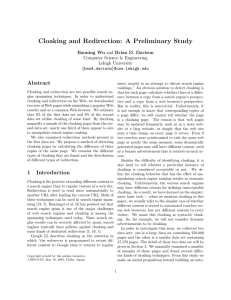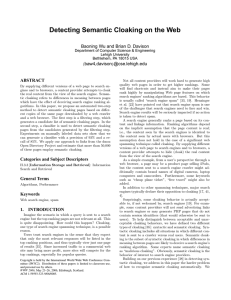cliquecloak
advertisement
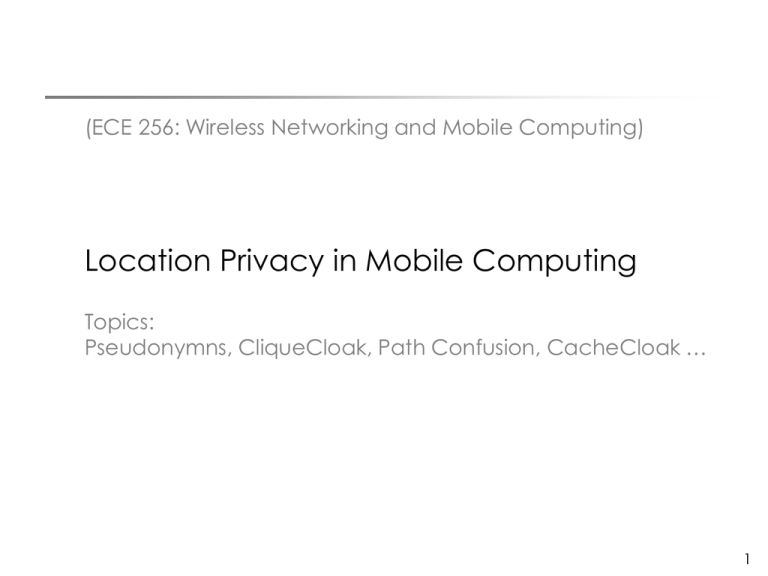
(ECE 256: Wireless Networking and Mobile Computing) Location Privacy in Mobile Computing Topics: Pseudonymns, CliqueCloak, Path Confusion, CacheCloak … 1 Context Better localization technology + Pervasive wireless connectivity = Location-based pervasive applications 2 Location-Based Apps For Example: GeoLife shows grocery list on phone when near WalMart Micro-Blog allows querying people at a desired region Location-based ad: Phone gets coupon at Starbucks … Location expresses context of user Facilitating content delivery Its as if Location is the IP address for content 3 Double-Edged Sword While location drives this new class of applications, it also violates user’s privacy Sharper the location, richer the app, deeper the violation 4 The Location Based Service Workflow Forward to local service: Request: Reply: Reply: Retrieve all available services in Retrieve all available services in location client’s location Client Server LBS Database (Location Based Service) 5 The Location Anonymity Problem Request: Retrieve all bus lines from location to address Client Server Privacy Violated = = LBS Database (Location Based Service) 6 Double-Edged Sword Moreover, range of apps are PUSH based. Require continuous location information Phone detected at Starbucks, PUSH a coffee coupon Phone located on highway, query traffic congestion 7 Location Privacy Problem: Continuous location exposure a serious threat to privacy Research: QuickTime™ and a TIFF (Uncompressed) decompressor are needed to see this picture. Preserve privacy without sacrificing the quality of continuous loc. based apps 8 Just Call Yourself ``Freddy” Pseudonymns Effective only when infrequent location exposure Else, spatio-temporal patterns enough to deanonymize … think breadcrumbs John Leslie Jack Susan Alex Romit’s Office 9 A Customizable k-Anonymity Model for Protecting Location Privacy Paper by: B. Gedik, L.Liu (Georgia Tech) Slides adopted from: Tal Shoseyov 10 Location Anonymity “A message from a client to a database is called location anonymous if the client’s identity cannot be distinguished from other users based on the client’s location information.” Database 11 k-Anonymity “A message from a client to a database is called location k-anonymous if the client cannot be identified by the database based on the client’s location from other k-1 clients.” 12 Implementation of Location Anonymity Server transforms the message byto“anonymizing” Database executes request Server forwards data Server sends the location datato in the the received according client Database replies to server “anonymized” message Client sends plain request data anonymous with compiled messagedata to the server 13 Implementation of Location k-Anonymity y Temporal Spatial Cloaking Cloaking – Setting – Setting a range a timeofinterval, space to be where a single allbox, the clients where all in aclients specific located location within the sending range area message said to beininthat the time “same interval location”. are said to have sent the message in the “same time”. x t 14 Implementation of Location k-Anonymity Spatial-Temporal Cloaking – Setting a range of space and a time interval, where all the messages sent by client inside the range in that time interval. This spatial and temporal area is called a “cloaking box”. t y x 15 Previous solutions M. Gruteser, D Grunwald (2003) – For a fixed k value, the server finds the smallest area around the client’s location that potentially contains k-1 different other clients, and monitoring that area over time until such k-1 clients are found. Drawback: Fixed anonymity value for all clients (service dependent) 16 The CliqueCloak Approach Definitions: Constraint Area: For a message m, a constraint area is a spatial-temporal area that contains the sending client’s location. A client sends his message along with a constraint area to prevent the database from sending the client useless information on locations outside the constraint area. y m k=3 x 17 The CliqueCloak Approach Definitions: Cloaking Box: A spatial and temporal area assigned to a transformed message. A valid cloaking box must comply to the following conditions: y 1. The client that sent the message m is located in the cloaking box m4 m2 2. The number of different clients inside the cloaking box must be at least m.k (the anonymity level of the message). k=3 k=3 m1 k=2 x 3. The cloaking box must be included inside the message’s constraint area. 18 The CliqueCloak Approach Definitions: Approach: Constraint Graph: An l-clique in that graph such that l ≥ mi.k for each i is mapped by the Each mobile node is a vertice in the algorithm to a spatial cloaking graph, and 2 nodes are connected iff box, where all messages in the each of them is inside the other clique will be transformed using node’s constraint area. the cloaking box, making each of the messages’ senders indistinguishable from one another. y m3 m2 m4 k=3 k=3 k=2 m1 k=2 x 19 The CliqueCloak Algorithm The Idea: • For each plain message, along with its constraints and anonymity level k, we try t to find a k-clique in the constraint graph and convert the clique into a spatial y cloaking box. x • Each of the messages inside the cloaking box will be converted into transformed messages, replacing their location values with the cloaking box. • We try finding a cloaking box for a message until it is expired (exceeds its temporal constraints). 20 Does CliqueCloak solve the location privacy problem? Any further concerns? Doubts? 21 Add Noise K-anonymity and CliqueCloak Convert location to a space-time bounding box Ensure K users in the box Location Apps reply to boxed region Bounding Box Issues You K=4 Poor quality of location Degrades in sparse regions Not real-time 22 Confuse Via Mixing Path intersections is an opportunity for privacy If users intersect in space-time, cannot say who is who later Issues Users may not be collocated in space and time Mixing still possible at the expense of delay 23 Existing solutions seem to suggest: Privacy and Quality of Localization (QoL) is a zero sum game Need to sacrifice one to gain the other 24 Ideal Solution Should Break away from this tradeoff Target: Spatial accuracy Real-time updates Privacy guarantees Even in sparse populations Another Idea: CacheCloak 25 CacheCloak Intuition Exploit mobility prediction to create future path intersections User’s paths are like crossroads of breadcrumbs App knows precise locations, but doesn’t know the user 26 CacheCloak Assume trusted privacy provider Reveal location to CacheCloak CacheCloak exposes anonymized location to Loc. App Loc. App1 Loc. App2 Loc. App3 Loc. App4 CacheCloak 27 CacheCloak Design User A drives down path P1 P1 is a sequence of locations CacheCloak has cached response for each location User A takes a new turn (no cached response) CacheCloak predicts mobility Deliberately intersects predicted path with another path P2 Exposes predicted path to application Application replies to queries for entire path CacheCloak always knows user’s current location Forwards cached responses for that precise location 28 CacheCloak Design Adversary confused New path intersects paths P1 and P2 (crossroads) Not clear where the user came from or turned onto Example … 29 Example 30 Benefits Real-time Response ready when user arrives at predicted location High QoL Responses can be specific to location Overhead on the wired backbone (caching helps) Entropy guarantees Entropy increases at traffic intersections In low regions, desired entropy possible via false branching Sparse population Can be handled with dummy users 31 Quantifying Privacy City converted into grid of small sqaures (pixels) Users are located at a pixel at a given time Each pixel associated with 8x8 matrix Element (x, y) = probability that user enters x and exits y y Probabilities diffuse At intersections Over time x pixel Privacy = entropy E user pixels pi log pi 32 Diffusion Probability of user’s presence diffuses Diffusion gradient computed based on history i.e., what fraction of users take right turn at this intersection Time t1 Time t2 Time t3 Road Intersection 33 Evaluation Trace based simulation VanetMobiSim + US Census Bureau trace data Durham map with traffic lights, speed limits, etc. 6km x 6km 10m x 10m pixel 1000 cars Vehicles follow Google map paths Performs collision avoidance 34 Results High average entropy Quite insensitive to user density (good for sparse regions) Minimum entropy reasonably high 35 Results Per-user entropy Increases quickly over time No user starves of location privacy 36 Issues and Limitations CacheCloak overhead Application replies to lots of queries However, overhead on wired infrastructure Caching reduces this overhead significantly CacheCloak assumes same, indistinguishable query Different queries can deanonymize Need more work Per-user privacy guarantee not yet supported Adaptive branching & dummy users 37 Closing Thoughts Two nodes may intersect in space but not in time Mixing not possible, without sacrificing timeliness Mobility prediction creates space-time intersections Enables virtual mixing in future 38 Closing Thoughts CacheCloak Implements the prediction and caching function Significant entropy attained even under sparse population Spatio-temporal accuracy remains uncompromised 39 Final Take Away Chasing a car is easier on highways … Much harder in Manhattan crossroads CacheCloak tries to turn a highway into a virtual Manhattan … Well, sort of … 40 Questions? 41 Emerging trends in content distribution Content delivered to a location / context As opposed to a destination address Thus, “location” is a key driver of content delivery IP address : Internet = Location : CDN New wave of applications 42 Emerging trends in content distribution Content delivered to a location / context As opposed to a destination address Thus, “location” is a key driver of content delivery IP address : Internet = Location : CDN New wave of applications 43 Example 44 Location Privacy Problem: Continuous location exposure deprives user of her privacy. QuickTime™ and a TIFF (Uncompressed) decompressor are needed to see this picture. 45 Location Frequency Some location apps are reactive / infrequent E.g., List Greek restaurants around me now (PULL) But, many emerging apps are proactive E.g., Phone detected at Starbucks, PUSH a coffee coupon 46 Location Frequency Some location apps are reactive / infrequent E.g., List Greek restaurants around me now (PULL) But, many emerging apps are proactive E.g., Phone detected at Starbucks, PUSH a coffee coupon Proactive apps require continuous location Opportunity for Big Bro to track you over space and time QuickTime™ and a TIFF (Uncompressed) decompressor are needed to see this picture. 47 Categorizing Apps Some location apps are reactive You ask, App answers E.g., Pull all Greek restaurants around your location But, many emerging apps are proactive E.g., Phone detected at Starbucks, PUSH a coffee coupon 48 Categorizing Apps Some location apps are reactive You ask, App answers E.g., Pull all Greek restaurants around your location But, many emerging apps are proactive E.g., Phone detected at Starbucks, PUSH a coffee coupon Proactive apps require continuous location QuickTime™ and a TIFF (Uncompressed) decompressor are needed to see this picture. 49




